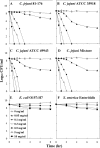Antibacterial activity and mechanism of action of zinc oxide nanoparticles against Campylobacter jejuni
- PMID: 21296935
- PMCID: PMC3067441
- DOI: 10.1128/AEM.02149-10
Antibacterial activity and mechanism of action of zinc oxide nanoparticles against Campylobacter jejuni
Abstract
The antibacterial effect of zinc oxide (ZnO) nanoparticles on Campylobacter jejuni was investigated for inhibition and inactivation of cell growth. The results showed that C. jejuni was extremely sensitive to treatment with ZnO nanoparticles. The MIC of ZnO nanoparticles for C. jejuni was determined to be 0.05 to 0.025 mg/ml, which is 8- to 16-fold lower than that for Salmonella enterica serovar Enteritidis and Escherichia coli O157:H7 (0.4 mg/ml). The action of ZnO nanoparticles against C. jejuni was determined to be bactericidal, not bacteriostatic. Scanning electron microscopy examination revealed that the majority of the cells transformed from spiral shapes into coccoid forms after exposure to 0.5 mg/ml of ZnO nanoparticles for 16 h, which is consistent with the morphological changes of C. jejuni under other stress conditions. These coccoid cells were found by ethidium monoazide-quantitative PCR (EMA-qPCR) to have a certain level of membrane leakage. To address the molecular basis of ZnO nanoparticle action, a large set of genes involved in cell stress response, motility, pathogenesis, and toxin production were selected for a gene expression study. Reverse transcription-quantitative PCR (RT-qPCR) showed that in response to treatment with ZnO nanoparticles, the expression levels of two oxidative stress genes (katA and ahpC) and a general stress response gene (dnaK) were increased 52-, 7-, and 17-fold, respectively. These results suggest that the antibacterial mechanism of ZnO nanoparticles is most likely due to disruption of the cell membrane and oxidative stress in Campylobacter.
Figures




References
-
- Arsène, F., T. Tomoyasu, and B. Bukau. 2000. The heat shock response of Escherichia coli. Int. J. Food Microbiol. 55:3-9. - PubMed
-
- Brayner, R., et al. 2006. Toxicological impact studies based on Escherichia coli bacteria in ultrafine ZnO nanoparticles colloidal medium. Nano Lett. 6:866-870. - PubMed
-
- Catrenich, C. E., and K. M. Makin. 1991. Characterization of the morphologic conversion of Helicobacter pylori from bacillary to coccoid forms. Scand. J. Gastroenterol. Suppl. 181:58-64. - PubMed
Publication types
MeSH terms
Substances
LinkOut - more resources
Full Text Sources
Other Literature Sources
Medical
Molecular Biology Databases
Research Materials

